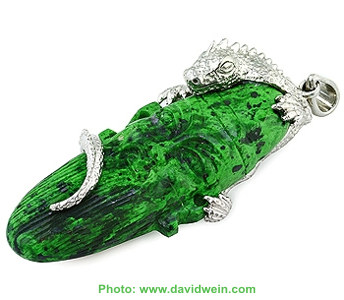Maw-Sit-Sit
Maw-sit-sit is one of the more unusual gemstones in the world, from its curious name to its variable chemical composition. It is a recent find, first identified in 1963 by the late Swiss gemologist Dr. Edward Gubelin. It was named after the village in northwestern Burma which is close to the site where it was first found. Typically maw-sit-sit is green with distinctive dark-green to black veining.
Maw-sit-sit is a chromium-rich metamorphic rock with brilliant emerald green blotches and bands interspersed with dark green-black blotches. It is found in Tawmaw, Myitkyina-Mogaung District, Kachin State, Myanmar. The source location for maw-sit-sit lies in the foothills of the Himalayas, near the historic imperial jadeite mines of northern Burma. Thus far maw-sit-sit has only been found in this single location, making it a rare material indeed. Because it is so rare, it is a popular gem among collectors but is not readily available through most jewelers. Because the gem is rare, it is typically set into gold rather than silver.
Some of the the confusion between jadeite and maw sit sit has to do with the fact that both stones are mined in the same area. For a long time, many assumed that maw sit sit was just a variety of the jade. It wasn’t until gemologist Eduard Gubelin studied the stones that it was determined that they are, in fact, two separate gemstones.
Maw-sit-sit is considered to be a rock rather than a mineral, since it is composed of a number of different minerals, including kosmochlor (a mineral related to jadeite) and varying amounts of jadeite and albite feldspar. It is often classified as a member of the jade family but it is not really a variety of jadeite. Sometimes maw-sit-sit is called a “cousin” of jade, which seems appropriate.

